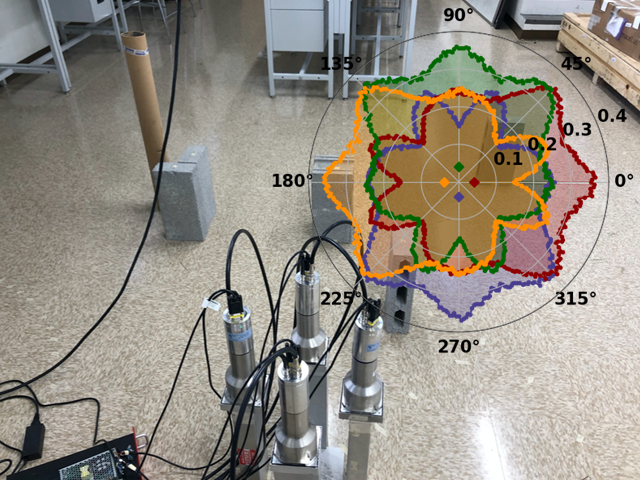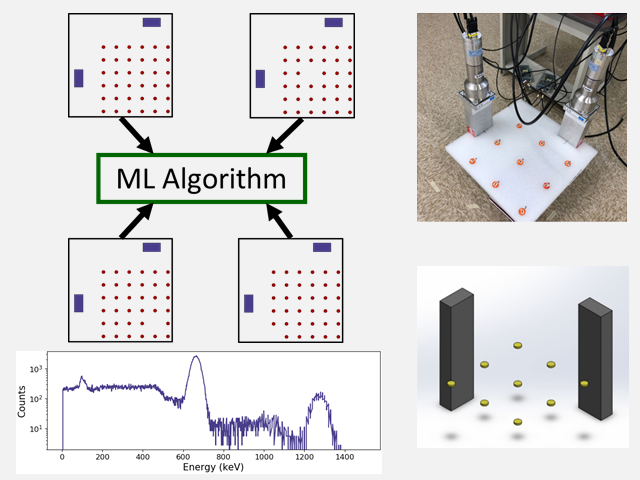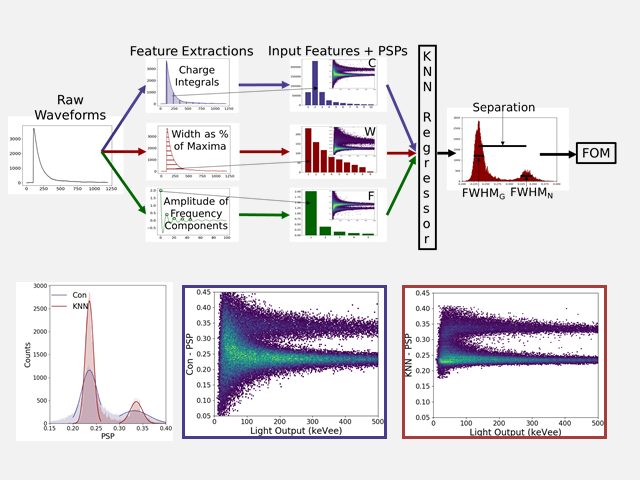Current Research
Moving Gamma Ray Source Localization
Static Gamma Ray Source Localization

Based largely on subtle differences in solid angle and array self-occlusion, a point-like gamma ray source will give an approximately unique distribution of counts across an array of stationary detectors based on the source location. Thus, by analyzing these subtle differences a source can theoretically be localized. In non-trivial environments, sources of scatter, attenuation, varying background radiation, and other sources of noise can greatly complicate the localization process. This project focuses on using various machine learning algorithms and techniques to improve overall localization capabilities. One algorithmic approach in recent literature involves comparisons to prepopulated reference tables. Preliminary results indicate that machine learning can better capture the relationship between the detector array response and gamma ray source location. These methods have the potential to be applied to various nuclear and homeland security applications, including urban radiation source search and cargo screenings.
Detecting Missing Radioactive material

For many safeguard and material accountancy applications, it is advantageous to be able to verify that all material within a sample is accounted for. If material is missing, it is also advantageous to identify the location within a sample that the missing material should be. For example, it is necessary to verify a lack of diversion in spent nuclear fuel assemblies and knowing which specific fuel rod or pin is missing can provide more context and more efficient secondary inspection efforts. One technique to detect for material unaccounted for (MUF) involves analyzing gamma ray spectroscopy measurements. This analysis can be complicated due to various sources of noise and predicting the location within a sample from which material is missing is not necessarily intuitive or straight forward. This project investigates various machine learning algorithms to investigate their potential use in this domain. Simple models of spent fuel assemblies were developed, including an array of sources to collect laboratory data. Machine learning algorithms showed promise in various diversion scenarios even when significant variance was introduced into the testing data, not accounted for in training data. Additionally, algorithms performed well when trained on a simulated array and tested on the laboratory array.
Pulse Shape Discrimination

Many detector types, like organic scintillators, are sensitive to both neutron and gamma rays. An individual pulse can theoretically be distinguished by looking into the florescent decay scheme, a process called pulse shape discrimination (PSD). While there are many investigations into machine learning and PSD, most (if not all) methods are supervised classification. This means that training pulses need to be labeled as neutrons or gamma rays prior to the machine learning phase. This calls for a separate PSD routine, which can introduce label bias. This project involves a novel regression approach, in which an k-nearest neighbors (kNN) algorithm is trained to regress upon conventionally calculated pulse shape parameters based on various input features extracted from the raw waveform. This allows for direct comparison to tradition methods by way of a figure of merit (FOM), without the burden of label bias. Datasets of pulses were gathered using various scintillators and light sensors (SiPMs and PMTs) of varying levels of innate PSD capabilities. Results showed that that not only can the FOM be improved over a large light output window, but the light output at which statistical separation of particle clusters can be achieved is lowed with the kNN regression method.
Past Research
Radiation Dammage in Gallium Nitride (GaN)
GaN can be fabricated into numerous electronic components and has vast electronic applications. Advances in growth techniques from recent years have allowed for a new crystal orientation: “N-face” GaN. N-face GaN has a few benefits over more common Ga-face GaN, including being faster and having the ability to operate at higher powers. This project has the goal of quantifying N-face GaN in terms of radiation damage and tolerance and comparing it to other orientations. I worked on this project my first year of graduate school and focused on the effects of gamma rays. I largely utilized MCNP to create simulations that correlated exposure to dose and interaction, when fed into calculations to quantify displacements and damage. I also got the opportunity to take part in irradiations at PSU, and Pacific Northwest National Laboratory (PNNL) in their High Exposure Facility (HEF).
Gamma-Gamma Coincidence Detection
Many nuclear decay modes result in the almost instantaneous emission of multiple gamma rays, said to be in coincidence. Gamma-gamma coincidence detection can detect these decays, by using multiple detectors with time stamping capabilities. Coincidence detection can greatly suppress the background, and therefore notably improve the signal-to-noise ratio (SNR). In addition, the temporal element of this method can allow for detection of signatures that are otherwise very difficult to detect. This project aimed to access, optimize, and compare coincidence systems of HPGe and LaBr3 detectors. Results showed that while HPGe has the typically expected benefits associated with higher energy resolution, LaBr3 detectors could operate in coincidence at much higher count rates. I got involved with this project during my undergrad, and it was my first exposure to radiation detection research. It was a great opportunity, and in addition to general assistance, I was tasked with determining the optimal timing window of each system.
Rotation Based Neutron Detection
A robotics team in collaboration with nuclear researchers developed a technique to characterize and map neutron sources remotely in old hot cells and radiation storage vaults. As part of that project, I characterized the response and rotational dependence of a B-10 based neutron detector with and with out shielding.
